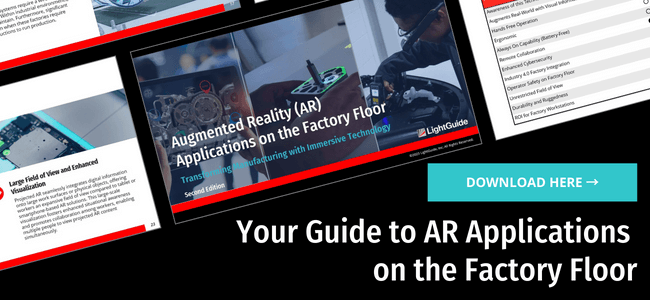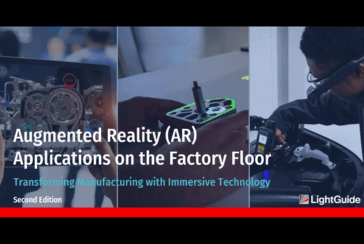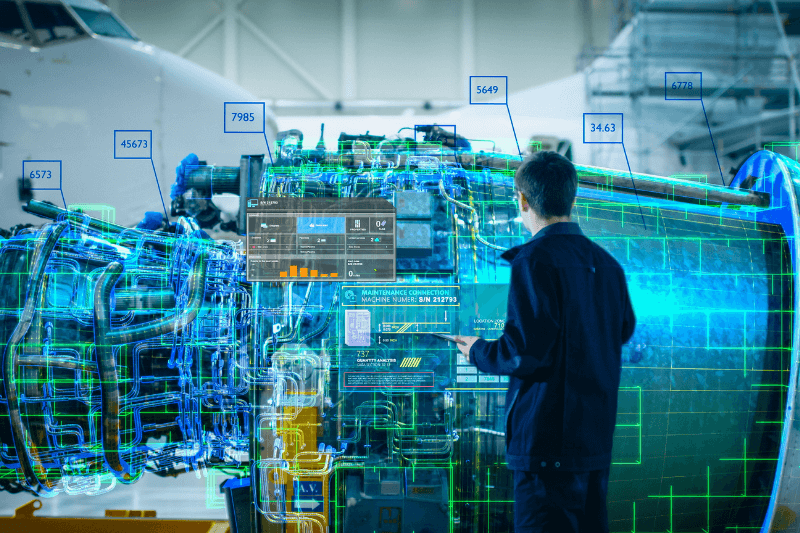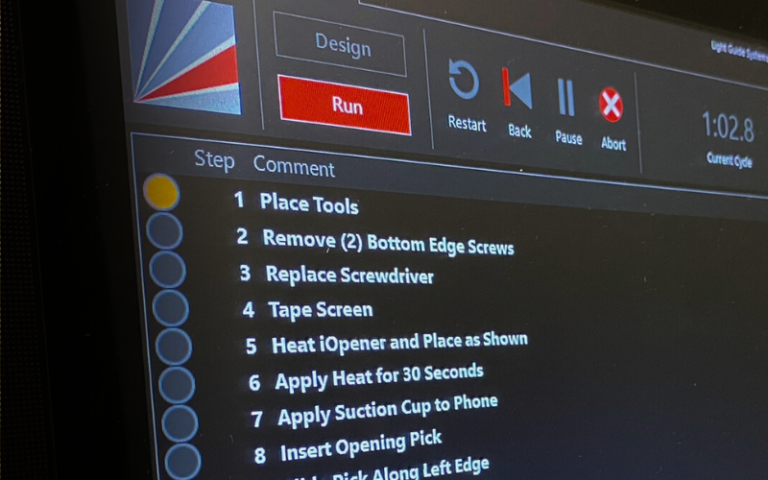6 Uses of Augmented Reality for Manufacturing In Every Industry

Augmented reality (AR) is changing the way we connect and interact in manufacturing. An enhanced version of the world around us, augmented reality is a combination of digital and audiovisual elements that connects the real and digital worlds.
Unlike virtual reality (VR), AR allows interaction between computer-generated information and the world around you. VR disengages the user from the real world, blocking their sense of true reality with headsets. AR, on the other hand, puts the two side-by-side. Whether it be placing a Pokémon on the sidewalk, visualizing a new chair in your office, or guiding work instructions on your workstation, these displays integrate a new reality into our current one. Together, AR enhances manufacturing capabilities, making it a perfect tool for Industry 4.0.
Augmented Reality in Manufacturing
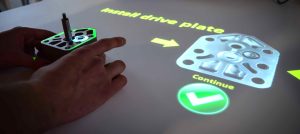
Manufacturers are investing more in human-and-machine interaction. To stay competitive, leading manufacturers continue to bring in automation to handle simple, repetitive tasks and track data. However, manual processes are still extremely relevant. Manufacturers are giving more complex tasks to their workers and increasing their agility to variation. By moving beyond these silos and empowering factories with augmentation, data and complex problem solving increases efficiency and productivity overall.
Augmented reality provides this connection. It guides and tracks manual processes, leading to new understanding of our operations. Research conducted on human and machine collaboration with the aid of AR at the University of Patras found that “AR interfaces can blend in the working environment and enrich it, making the interaction with [robots] natural and intuitive.”
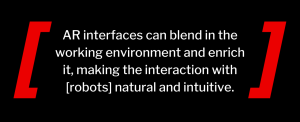
Research like this shows that human and machine connection using AR aids leading manufacturers in identifying challenges. From the slightest motions detected by 3D sensors and machine vision cameras, the best AR solutions for manufacturing can identify minute data points. Aggregating that data leads manufacturers to the exact moments enterprise-level inefficiencies occur and shows them how to optimize operations for increased productivity.
Let’s explore some of the major benefits of using augmented reality for manufacturing.
6 Uses Cases of AR in Manufacturing That Are Driving Operational Efficiency
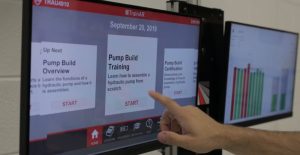
1. Training & Upskilling
Leveraging AR solutions to solve manufacturing training and upskilling challenges benefits businesses and workers at all levels. Digital AR work instructions scale to meet businesses where they are, whether they need to train at the individual, factory, or enterprise level. A click of a button easily switches programs, providing production training for individuals or large groups. These programs easily adapt to any skill level, remaining inclusive for someone with little manufacturing background or someone with 30+ years of experience.
RELATED ARTICLE: Manufacturing’s Unexpected Solution to the Great Resignation: Digital Transformation
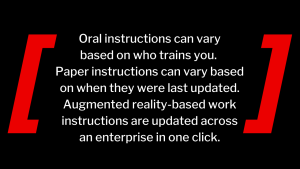
Above all, digital work instructions standardize training. Oral instructions can vary based on who trains you. Paper instructions can vary based on when they were last updated. Augmented reality work instructions are updated across an enterprise in one click. Connected systems update simultaneously, ensuring no lapse in information. Plus, digital work instructions ensure the information is the same at every workstation.
2. Digital Work Instructions
Similarly, AR work instructions guide workers through standardized processes. Instead of a worker reading about three actions at once with only one picture to demonstrate it, AR projects work instructions directly onto the work surface, guiding workers one step at a time. Therefore, all focus is on the quality of that one action, significantly reducing time, errors, and cognitive load on the worker.
Along with that, AR makes writing digital work instructions easier. By adding visual and audio cues into the steps, less text is needed. In systems like LightGuide’s AR software, there are additional sensory features like audio cues, blinking lights, animations, and videos to draw attention to the instructions. All of these features can be programmed with a drag-and-drop interface, cutting down the time needed to create work instructions for manufacturing and assembly processes.
RELATED ARTICLES:
Digital Work Instructions Explained: The Ultimate Guide
6 Tips for Writing Practical Work Instructions
3. Product Variation
Once work instructions are written, they are added to an index of programs available on every AR system. With more than one process available to work on per system, workers are open to quickly and conveniently adapt to product variation. One barcode scan allows AR software connected to an enterprise MES or PLC system to recognize a new part and automatically call the proper work instructions.
4. Quality Assurance
Inspection and verification are extremely important to ensuring quality. However, it’s still common that inspections don’t take place until the end of a process. With guided AR solutions, work instructions can incorporate quick inspections at any step without hindering cycle time.
LightGuide’s AR software even integrates with 3D vision cameras and machine learning to identify errors like proper torque, correct wire placement, and counting based on part type. It stores all inspection information—along with all process data—and even adds snapshots for added assurance. On top of that, LightGuide AR software includes a no-fault-forward step structure. This means that a worker can’t move on to the next step until they are absolutely sure the current one is correct.
5. Ergonomics
Because augmented reality displays digital overlays onto the surfaces around you, it can adapt to your needs. Not everyone works in the same setting. Adjustments are needed for the type of work you’re doing, where you’re doing it, and how much you’re doing at a time. In ergonomics, these are defined as physical, cognitive, and organizational needs. Together, ergonomics largely impacts the way your workers interact with their jobs.
AR digital work instructions are customizable. When changes need to be made to accommodate workers, it can be done in minutes. In addition, digital work instructions can offer text in multiple languages. Although the visual and auditory elements make little text necessary—automatically reducing language barriers—added buttons can make switching language options instantaneous.
RELATED ARTICLE: What Is Ergonomics?
6. Manual Process Data & Analytics
The rise of automation also led to a rise in available process data. However, manual processes are still relevant and manufacturers rarely aggregate any new data from them. Augmentation makes both processes work together.
AR technology allows manufacturers to access manual process and automated data at the same time. It continues to collect cycle times and defects but adds more minute points of reference. For example, augmented work instructions track step times, the exact actions that led to a defect, and real-time operational metrics. Altogether, this added manual data provides a broader picture of factory functionality, showing exactly when and where issues occur.
RELATED ARTICLE: The AR Analytics Tool Making Manufacturing Data More Accessible
Manufacturing Industries Benefiting From Augmented Reality
Manufacturers in a variety of industries worldwide are investing in AR solutions. Although they face different challenges, AR is versatile enough to solve every one of them and provide added benefits.
Here’s a look at how leading manufacturers are using augmented reality to drive operational efficiency.
1. Automotive Manufacturing
It’s an understatement to say there is variation in automotive manufacturing. Ford alone has 41 different vehicle models around the world. And that doesn’t include the variants of some models, which can mean there are up to 15 different styles for models like the Ford Ranger. Then, add all the different color options available for each model and individual customizations…
All of these options mean production can change quickly. In one hour workers might assemble a handle for the Ford Ranger and then the next hour the Mustang. Augmented reality applies to automotive manufacturing by making those changes instantaneous and efficient, given the extreme variation that both OEMs and tiered suppliers have to produce.
A great use case to visualize with AR in automotive manufacturing is the assembly of headliners. When a part that large comes rolling down the line, a worker needs to know exactly where to lay the padding, glue, wire harness, and/or other components. Often, to match the model they’re working on, those placements need to be within millimeters.
By adding digital work instructions a worker is given an exact template of what to produce. The placements are mapped out onto the part so there is no guesswork in the placement. Errors are reduced substantially and productivity and efficiency skyrocket.
RELATED ARTICLE: 3 Uses of Augmented Reality in Automotive Manufacturing
2. Aerospace & Defense Manufacturing
In aerospace and defense, quality is the name of the game. Products need a 100% guarantee they’re correctly assembled, even if it reduces throughput. Think about it, you would be willing to wait to get on a plane that you were sure wasn’t missing bolts.
And ironically, despite the innovative technology within aerospace and defense products, the industry itself is behind. Often, these factories are still functioning with oral and written work instructions. Having tribal knowledge is power. However, the rise of the great resignation is increasing the skills gap significantly in this industry.
Augmented reality applications extend to aerospace and defense manufacturing by ensuring quality and standardizing and digitizing work instructions. LightGuide AR software’s no-fault-forward steps provide another method of confirmation, making sure the worker cannot move forward until the steps are completed correctly.
Additionally, using digitized work instructions improves process flow. Aerospace and defense work with high variation and long standard cycle times and benefit from a single-piece flow process. This means sub-assemblies are built at each station and are passed along until the part is completed. With AR work instructions, workers view the step instructions right where they need them and are confirmed in each step of the process, preventing and eliminating errors.
AR work instructions deliver an extra, surprising benefit as well. As AR software tracks manual process data, it captures snapshots and data points normally lost. In aerospace in defense, this “digital birth certificate” of the part’s conception is additional liability insurance.
RELATED ARTICLE: How to Adopt Augmented Reality for Quality Control In Aerospace Manufacturing
3. Electronics Manufacturing
In electronics manufacturing, both quantity and quality are critical. Most electronics manufacturing is not actually performed by the brand names seen on laptops and smartphones. In reality, it’s completed by contract manufacturers.
Because so much of the work is contracted out, the brand name electronics companies require extremely low margins of error to maintain business relationships (as low as 1-2%). Therefore, contractors need to employ workers that can learn quickly and work without error. However, turnover rates are immense in this industry. It makes it hard to retain workers once they are brought on and have them maintain the factory’s standards.
On top of that, the electronics industry is constantly innovating. Think about how many new smartphone models are released per year. Now, imagine how many times work instructions need to be updated throughout that same time frame.
Retaining and retraining workers is keeping contract manufacturers in a chronic state of low productivity. Luckily, AR guided work instructions train and retrain in a simple, agile way. Systems like LightGuide’s TrainAR provide dual functions for this purpose, acting as a training unit that can be included in production on the factory floor. It visualizes work instructions, making them easier and faster to comprehend. Then, workers in training pick up processes faster but without error. Plus, as mentioned earlier, multiple programs can live on one system, making it adaptable to variation.
RELATED ARTICLE: 3 Electronics Manufacturing Challenges Augmented Reality Solves
4. Medical Manufacturing
To get FDA approval, medical and pharmaceutical manufacturers need to follow strict standard procedures and verification methods. Integrity is key. Whether for kitting, pill counting, or preparation for drug development, every process needs to ensure the safety of the operator and end-user.
To guarantee safety, medical manufacturers are turning to augmented reality verification. By adding 3D sensors to LightGuide AR software, manufacturers confirm a process step—such as which bin a component should be picked from, what tool to use, and where the component should be placed—is performed correctly. Product validation can be achieved with high-precision machine vision cameras and other sensor technology to confirm the product is properly assembled, down to the last bolt or screw.
RELATED ARTICLE: A Complete Guide to Augmented Reality for Medical Manufacturing
Types of Augmented Reality for Manufacturing
Currently, there are three main types of AR being used to support manufacturing and assembly operations. Each of these delivers an immersive experience that enhances operations. But based on a factory’s environment and needs, knowing which type of AR best matches an application will lead to the most operational success.
Tablet Augmented Reality for Manufacturing
Tablet AR technology is a combination of tablets and other hand-held devices (like smartphones) that present work instructions through AR apps. Most people are aware of the AR applications on social media, like Snapchat filters. However, tablets and phones have made their way into industry more and more over the past few years.
Tablet AR is particularly easy to use. Most people are familiar with tablet technology, making training simple and shortening start-up time.
Wearable Augmented Reality in Manufacturing
Wearable AR technology projects an overlay of graphics onto the environment around you through AR glasses or a headset. Most people are familiar with AR smart glasses like Google Glass and Microsoft HoloLens. These act as lightweight, hands-free computers to display and store information.
Compared to tablet AR, wearable AR is a popular choice in factories due to its mobility and dynamic graphics.
Projected AR Solutions for Manufacturing
Projected AR uses a combination of projectors and vision sensors to display virtual step-by-step interactive graphics onto any work surface. It is usable across a wide range of manufacturing solutions, including assembly, part picking and kitting, testing and inspection, training, and maintenance.
Projection-based augmented reality is the most versatile of all augmented reality types. It is the best AR solution for all manufacturing industries and provides the most enterprise benefits.
RELATED ARTICLE: How to Determine the Best Type of Augmented Reality for Your Factory
The Future of Augmented Reality in Manufacturing

Augmented reality is already a leading technology for manufacturing worldwide. And investment will only continue to grow. It’s estimated that “By 2025…industrial AR will reach a market value of $70 billion.”
Expanding on human and machine collaboration is unlocking new methods to connect our factories and interact with data. Enterprises in every industry are benefitting from solutions to manufacturing training, standardization, optimization, and overall worker well-being.

Ready to Use LightGuide to Improve your Manufacturing Processes?
Connect with our team to see how the LightGuide AR platform can transform your operations.


